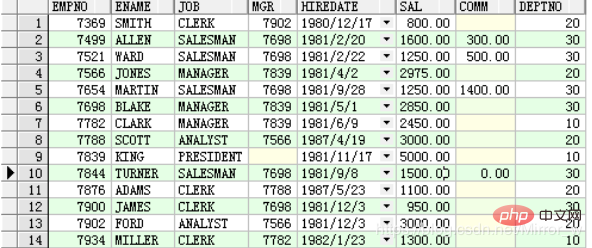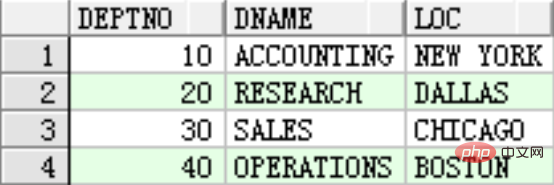Frequently asked Oracle interview questions

EMP table

DEPT table:

Salary grade table salgrade

Question requirements: Complete the following operations based on the emp table and dept table in the Oracle database scott mode.
(1)查询20号部门的所有员工信息。
select * from emp where deptno = 20;
(2)查询所有工种为CLERK的员工的工号、员工名和部门名。
select empno,ename,deptno from emp where job like 'CLERK';
(3)查询奖金(COMM)高于工资(SAL)的员工信息。
select * from emp where comm > sal;
(4)查询奖金高于工资的20%的员工信息。
select * from emp where comm > (sal*0.2);
(5)查询10号部门中工种为MANAGER和20号部门中工种为CLERK的员工的信息。
select * from emp
where (deptno = 10 and job like 'MANAGER') or (deptno = 20 and job like 'CLERK');
(6)查询所有工种不是MANAGER和CLERK,且工资大于或等于2000的员工的详细信息。
select * from emp
where job not in ('MANAGER','CLERK') and sal >= 2000 ;
(7)查询有奖金的员工的不同工种。
select distinct job from emp where comm is not null;
(8)查询所有员工工资和奖金的和。
select ename,(sal+nvl(comm,0)) salcomm from emp;
(9)查询没有奖金或奖金低于100的员工信息。
select * from emp where (comm is null or comm < 100) ;
(10)查询各月倒数第2天入职的员工信息。
select * from emp where hiredate in (select (last_day(hiredate)-1) from emp);
(11)查询员工工龄大于或等于10年的员工信息。
select * from emp where (sysdate - hiredate)/365 >= 10 ;
(12)查询员工信息,要求以首字母大写的方式显示所有员工的姓名。
select upper(substr(ename,1,1)) || lower(substr(ename,2,length(ename)-1)) from emp;
(13)查询员工名正好为6个字符的员工的信息。
select * from emp where length(ename)= 6 ;
(14)查询员工名字中不包含字母“S”员工。
select * from emp where ename not in (select ename from emp where ename like '%S%') ;
select * from emp where ename not like ‘%S%’;
(15)查询员工姓名的第2个字母为“M”的员工信息。
select * from emp where ename like '_M%';
(16)查询所有员工姓名的前3个字符。
select substr(ename,1,3) from emp ;
(17)查询所有员工的姓名,如果包含字母“s”,则用“S”替换。
select replace(ename,'s','S') from emp ;
(18)查询员工的姓名和入职日期,并按入职日期从先到后进行排列。
select ename,hiredate from emp order by hiredate asc ;
(19)显示所有的姓名、工种、工资和奖金,按工种降序排列,若工种相同则按工资升序排列。
select ename,job,sal,comm from emp order by job desc,sal asc ;
(20)显示所有员工的姓名、入职的年份和月份,若入职日期所在的月份排序,若月份相同则按入职的年份排序。
select ename,to_char(hiredate,'yyyy')||'-'||to_char(hiredate,'mm') from emp order by to_char(hiredate,'mm'),to_char(hiredate,'yyyy');
(21)查询在2月份入职的所有员工信息。
select * from emp where to_char(hiredate,'mm') = 2 ;
(22)查询所有员工入职以来的工作期限,用“**年**月**日”的形式表示。
select ename,floor((sysdate-hiredate)/365)||'年'||floor(mod((sysdate-hiredate),365)/30)||'月'||cell(mod(mod((sysdate-hiredate),365),30))||'天' from emp ;
(23)查询至少有一个员工的部门信息。
select * from dept where deptno in (select distinct deptno from emp where mgr is not null) ;
(24)查询工资比SMITH员工工资高的所有员工信息。
select * from emp where sal > (select sal from emp where ename like 'SMITH') ;
(25)查询所有员工的姓名及其直接上级的姓名。
select staname,ename supname from (select ename staname,mgr from emp) t join emp on t.mgr=emp.empno ;
(26)查询入职日期早于其直接上级领导的所有员工信息。
select * from emp where empno in (select staempno from (select empno staempno,hiredate stahiredate,mgr from emp) t join emp on t.mgr=emp.empno and stahiredate < hiredate) ;
(27)查询所有部门及其员工信息,包括那些没有员工的部门。
select * from dept left join emp on emp.deptno=dept.deptno order by dept.deptno ;
(28)查询所有员工及其部门信息,包括那些还不属于任何部门的员工。
(29)查询所有工种为CLERK的员工的姓名及其部门名称。
select ename,dname from emp join dept on job like 'CLERK' and emp.deptno=dept.deptno ;
(30)查询最低工资大于2500的各种工作。
select job from (select min(sal) min_sal,job from emp group by job) where min_sal > 2500 ;
(31)查询最低工资低于2000的部门及其员工信息。
select * from emp where deptno in (select deptno from (select min(sal) min_sal,deptno from emp group by deptno) where min_sal < '2000') ;
(32)查询在SALES部门工作的员工的姓名信息。
select ename from emp where deptno = (select deptno from dept where dname like 'SALES');
(33)查询工资高于公司平均工资的所有员工信息。
select * from emp where sal > (select avg(sal) from emp) ;
(34)查询与SMITH员工从事相同工作的所有员工信息。
select * from emp where job in (select job from emp where ename like 'SMITH') and ename not like 'SMITH' ;
(35)列出工资等于30号部门中某个员工工资的所有员工的姓名和工资。
select ename,sal from emp where sal =any (select sal from emp where deptno = 30) ;
(36)查询工资高于30号部门中工作的所有员工的工资的员工姓名和工资。
select ename,sal from emp where sal >all (select sal from emp where deptno = 30) ;
(37)查询每个部门中的员工数量、平均工资和平均工作年限。
select dname,count,avg_sal,avg_date from dept join (select count(*) count,avg(sal) avg_sal,avg((sysdate-hiredate)/365) avg_date,deptno from emp group by deptno) t on dept.deptno = t.deptno ;
(38)查询从事同一种工作但不属于同一部门的员工信息。
select distinct t1.empno,t1.ename,t1.deptno from emp t1 join emp t2 on t1.job like t2.job and t1.deptno <> t2.deptno ;
(39)查询各个部门的详细信息以及部门人数、部门平均工资。
Select dept.*,person_num,avg_sal from dept,(select count(*) person_num,avg(sal) avg_sal,deptno from emp group by deptno) t where dept.deptno = t.deptno ;
(40)查询各种工作的最低工资。
select job,min(sal) from emp group by job ;
(41)查询各个部门中的不同工种的最高工资。
select max(sal),job,deptno from emp group by deptno,job order by deptno,job ;
(42)查询10号部门员工以及领导的信息。
select * from emp where empno in (select mgr from emp where deptno=10) or deptno = 10 ;
(43)查询各个部门的人数及平均工资。
select deptno,count(*),avg(sal) from emp group by deptno ;
(44)查询工资为某个部门平均工资的员工信息。
select * from emp where sal in (select avg(sal) avg_sal from emp group by deptno) ;
(45)查询工资高于本部门平均工资的员工的信息。
select emp.* from emp join (select deptno,avg(sal) avg_sal from emp group by deptno) t on emp.deptno=t.deptno and sal>avg_sal ;
(46)查询工资高于本部门平均工资的员工的信息及其部门的平均工资。
select emp.*, from emp join (select deptno,avg(sal) avg_sal from emp group by deptno) t on emp.deptno=t.deptno and sal>avg_sal ;
(47)查询工资高于20号部门某个员工工资的员工的信息。
select * from emp where sal >any(select sal from emp where deptno=20);
(48)统计各个工种的人数与平均工资。
select job,count(*),avg(sal) from emp group by job ;
(49)统计每个部门中各个工种的人数与平均工资。
select deptno,job,count(*),avg(sal) from emp group by deptno,job order by deptno,job;
(50)查询工资、奖金与10 号部门某个员工工资、奖金都相同的员工的信息。
select emp.* from emp join (select sal,comm from emp where deptno = 10) t on emp.sal=t.sal and nvl(emp.comm,0)=nvl(t.comm,0) and emp.deptno != 10;
(51)查询部门人数大于5的部门的员工的信息。
select * from emp where deptno in (select deptno from emp group by deptno having count(*)>5);
(52)查询所有员工工资都大于1000的部门的信息。
select * from dept where deptno in (select distinct deptno from emp where deptno not in (select distinct deptno from emp where sal < 1000)) ;
(53)查询所有员工工资都大于1000的部门的信息及其员工信息。
select * from emp join dept on dept.deptno in (select distinct deptno from emp where deptno not in (select distinct deptno from emp where sal < 1000)) and dept.deptno=emp.deptno;
(54)查询所有员工工资都在900~3000之间的部门的信息。
select * from dept where deptno in (select distinct deptno from emp where deptno not in (select distinct deptno from emp where sal not between 900 and 3000)) ;
(55)查询所有工资都在900~3000之间的员工所在部门的员工信息。
select * from emp where deptno in (select distinct deptno from emp where deptno not in (select distinct deptno from emp where sal not between 900 and 3000)) ;
(56)查询每个员工的领导所在部门的信息。
select * from (select e1.empno,e1.ename,e1.mgr mno,e2.ename mname,e2.deptno from emp e1 join emp e2 on e1.mgr=e2.empno) t join dept on t.deptno=dept.deptno ;
(57)查询人数最多的部门信息。
select * from dept where deptno in (select deptno from (select count(*) count,deptno from emp group by deptno) where count in (select max(count) from (select count(*) count,deptno from emp group by deptno)));
(58)查询30号部门中工资排序前3名的员工信息。
select * from emp where empno in (select empno from (select empno,sal from emp where deptno=30 order by sal desc) where rownum < 4) ;
(59)查询所有员工中工资排在5~10名之间的员工信息。
select * from emp where empno in (select empno from (select empno,rownum num from (select empno,sal from emp order by sal desc)) where num between 5 and 10 ) ;
select empno from (select empno,sal from emp order by sal desc) where rownum <= 10 minus select empno from (select empno,sal from emp order by sal desc) where rownum < 5 ;
(60)向emp表中插入一条记录,员工号为1357,员工名字为oracle,工资为2050元,部门号为20,入职日期为2002年5月10日。
insertinto emp(empno,ename,sal,deptno,hiredate) values (1357,'oracle',2050,20,to_date('2002年5月10日','yyyy"年"mm"月"dd"日"')) ;
(61)向emp表中插入一条记录,员工名字为FAN,员工号为8000,其他信息与SMITH员工的信息相同。
(62)将各部门员工的工资修改为该员工所在部门平均工资加1000。
update emp t1 set sal = (select new_sal from (select avg(sal)+1000 new_sal,deptno from emp group by deptno) t2 wher e t1.deptno = t2.deptno ) ;
1、查询82年员工
select e.* from emp e where to_char(e.hiredate, 'yy') like '82';
select e.* from emp e where to_char(e.hiredate,'yyyy')='1982';
2、查询32年工龄的人员
select round(sysdate-e.hiredate)/365, e.ename,e.hiredate from emp e where round((sysdate-e.hiredate)/365)=32;
3、显示员工雇佣期 6 个月后下一个星期一的日期
select next_day(add_months(e.hiredate,6),2) from emp e ;
4、找没有上级的员工,把mgr的字段信息输出为 "boss"
select decode(e.mgr,null,'boss','中国好声音') from emp e;
5、为所有人长工资,标准是:10部门长10%;20部门长15%;30部门长20%其他部门长18%
select decode(e.deptno,10,e.sal*1.1,20,e.sal*1.15, e.sal*1.18) 涨工资 ,e.deptno, e.sal from emp e ;
Oracle_练习与答案
1.求部门中薪水最高的人
select ename,sal,emp.deptno from emp
join (select deptno,max(sal) max_sal from emp group by deptno) t
on (emp.deptno = t.deptno and emp.sal = t.max_sal);
select ename, sal, deptno
from emp
where sal in (select max(sal) from emp group by deptno);
2.求部门平均薪水的等级
select deptno, avg_sal, grade from
(select deptno,avg(sal) avg_sal from emp group by deptno) t
join salgrade
on (t.avg_sal between salgrade.losal and salgrade.hisal);
3. 求部门平均的薪水等级
select deptno, avg(grade) avg_sal_grade from (select deptno, grade from emp
join salgrade on emp.sal between salgrade.losal and salgrade.hisal) group by deptno;
4. 雇员中有哪些人是经理人
select distinct e2.ename manager from emp e1 join emp e2 on e1.mgr = e2.empno;
select ename from emp where empno in (select mgr from emp);
5. 不准用组函数,求薪水的最高值
select distinct sal max_sal from emp where sal not in
(select e1.sal e1_sal from emp e1 join emp e2 on e1.sal < e2.sal);
select * from (select * from emp order by sal desc) t where rownum <2
6. 求平均薪水最高的部门的部门编号
select deptno, avg_sal from (select deptno, avg(sal) avg_sal from emp group by deptno)
where avg_sal = (select max(avg_sal) from (select avg(sal) avg_sal from emp group by
deptno) );
组函数嵌套写法(对多可以嵌套一次,group by 只对内层函数有效)
select deptno, avg_sal from
(select deptno, avg(sal) avg_sal from emp group by deptno) where avg_sal =
(select max(avg(sal)) from emp group by deptno);
7. 求平均薪水最高的部门的部门名称
select t1.deptno, dname, avg_sal from (select deptno,avg(sal) avg_sal from emp group by deptno) t1 join dept on t1.deptno = dept.deptno where avg_sal = (select max(avg_sal) from
(select deptno,avg(sal) avg_sal from emp group by deptno) );
select dname from dept where deptno = (select deptno from
(select deptno,avg(sal) avg_sal from emp group by deptno) where avg_sal =
(select max(avg_sal) from
(select deptno,avg(sal) avg_sal from emp group by deptno) ) );
8. 求平均薪水的等级最低的部门的部门名称
select dname from dept join (select deptno, grade from
(select deptno, avg(sal) avg_sal from emp group by deptno) t join salgrade
on (t.avg_sal between salgrade.losal and salgrade.hisal) ) t
on dept.deptno = t.deptno where t.grade = (select min(grade) from
(select avg(sal) avg_sal from emp group by deptno) t join salgrade
on (t.avg_sal between salgrade.losal and salgrade.hisal) );
9.求部门经理人中平均薪水最低的部门名称
select dname from (select deptno, avg(sal) avg_sal from emp where empno in (select mgr from emp)group by deptno)t join dept on t.deptno = dept.deptno where avg_sal = (select min(avg_sal) from (select avg(sal) avg_sal from emp where empno in
(select mgr from emp) group by deptno) t );
10. 求比普通员工的最高薪水还要高的经理人名称(not in)
select ename from emp where empno in (select mgr from emp) and sal > (select max(sal) from (select e2.sal from emp e1 right join emp e2 on e1.mgr = e2.empno where e1.ename is null) t );
select ename from emp where empno in (select mgr from emp) and sal >
(select max(sal) from emp where empno not in (select distinct mgr from emp where mgr is not null) );
//NOT IN遇到NULL则返回NULL,必须排除NULL值
11. 求薪水最高的前5名雇员
select empno,ename from (select * from emp order by sal desc) where rownum<=5;
12. 求薪水最高的第6到第10名雇(!important)
select ename,sal from (select t.*,rownum r from (select * from emp order by sal desc) t
) where r>=6 and r<=10;
13. 求最后入职的5名员工
select ename, to_char(hiredate,'YYYY"年"MM"月"DD"日"') hiredate from (select t.*,rownum r from (select * from emp order by hiredate desc)t )
where r<=5;
select ename, to_char(hiredate,'YYYY"年"MM"月"DD""') hiredate from (select t.*,rownum r from
(select * from emp order by hiredate)t
)where r>(select count(*)-5 from emp);[Topic recommendation]:2020 Oracle interview questions summary (latest)
The above is the detailed content of Frequently asked Oracle interview questions. For more information, please follow other related articles on the PHP Chinese website!

Hot AI Tools

Undresser.AI Undress
AI-powered app for creating realistic nude photos

AI Clothes Remover
Online AI tool for removing clothes from photos.

Undress AI Tool
Undress images for free

Clothoff.io
AI clothes remover

AI Hentai Generator
Generate AI Hentai for free.

Hot Article

Hot Tools

Notepad++7.3.1
Easy-to-use and free code editor

SublimeText3 Chinese version
Chinese version, very easy to use

Zend Studio 13.0.1
Powerful PHP integrated development environment

Dreamweaver CS6
Visual web development tools

SublimeText3 Mac version
God-level code editing software (SublimeText3)

Hot Topics
 1377
1377
 52
52
 How do I create users and roles in Oracle?
Mar 17, 2025 pm 06:41 PM
How do I create users and roles in Oracle?
Mar 17, 2025 pm 06:41 PM
The article explains how to create users and roles in Oracle using SQL commands, and discusses best practices for managing user permissions, including using roles, following the principle of least privilege, and regular audits.
 How do I perform online backups in Oracle with minimal downtime?
Mar 17, 2025 pm 06:39 PM
How do I perform online backups in Oracle with minimal downtime?
Mar 17, 2025 pm 06:39 PM
The article discusses methods for performing online backups in Oracle with minimal downtime using RMAN, best practices for reducing downtime, ensuring data consistency, and monitoring backup progress.
 How do I configure encryption in Oracle using Transparent Data Encryption (TDE)?
Mar 17, 2025 pm 06:43 PM
How do I configure encryption in Oracle using Transparent Data Encryption (TDE)?
Mar 17, 2025 pm 06:43 PM
The article outlines steps to configure Transparent Data Encryption (TDE) in Oracle, detailing wallet creation, enabling TDE, and data encryption at various levels. It also discusses TDE's benefits like data protection and compliance, and how to veri
 How do I use Automatic Workload Repository (AWR) and Automatic Database Diagnostic Monitor (ADDM) in Oracle?
Mar 17, 2025 pm 06:44 PM
How do I use Automatic Workload Repository (AWR) and Automatic Database Diagnostic Monitor (ADDM) in Oracle?
Mar 17, 2025 pm 06:44 PM
The article explains how to use Oracle's AWR and ADDM for database performance optimization. It details generating and analyzing AWR reports, and using ADDM to identify and resolve performance bottlenecks.
 How do I use flashback technology to recover from logical data corruption?
Mar 14, 2025 pm 05:43 PM
How do I use flashback technology to recover from logical data corruption?
Mar 14, 2025 pm 05:43 PM
Article discusses using Oracle's flashback technology to recover from logical data corruption, detailing steps for implementation and ensuring data integrity post-recovery.
 Oracle PL/SQL Deep Dive: Mastering Procedures, Functions & Packages
Apr 03, 2025 am 12:03 AM
Oracle PL/SQL Deep Dive: Mastering Procedures, Functions & Packages
Apr 03, 2025 am 12:03 AM
The procedures, functions and packages in OraclePL/SQL are used to perform operations, return values and organize code, respectively. 1. The process is used to perform operations such as outputting greetings. 2. The function is used to calculate and return a value, such as calculating the sum of two numbers. 3. Packages are used to organize relevant elements and improve the modularity and maintainability of the code, such as packages that manage inventory.
 How do I create and manage tables, views, indexes, and other database objects in Oracle?
Mar 14, 2025 pm 05:52 PM
How do I create and manage tables, views, indexes, and other database objects in Oracle?
Mar 14, 2025 pm 05:52 PM
The article discusses creating and managing Oracle database objects like tables, views, and indexes using SQL commands. It covers best practices for performance optimization, ensuring data integrity and security, and using tools for automation.
 How do I perform switchover and failover operations in Oracle Data Guard?
Mar 17, 2025 pm 06:37 PM
How do I perform switchover and failover operations in Oracle Data Guard?
Mar 17, 2025 pm 06:37 PM
The article details procedures for switchover and failover in Oracle Data Guard, emphasizing their differences, planning, and testing to minimize data loss and ensure smooth operations.




